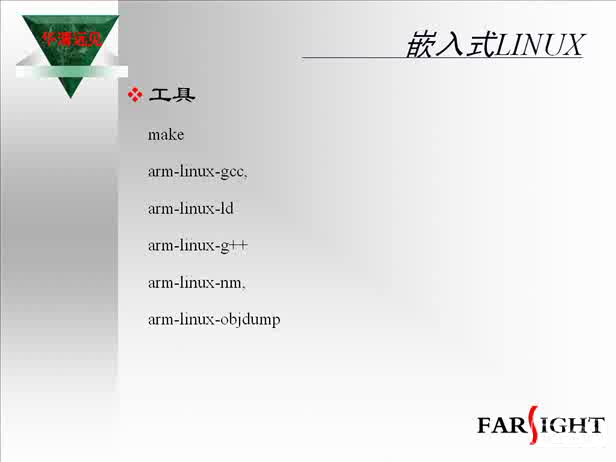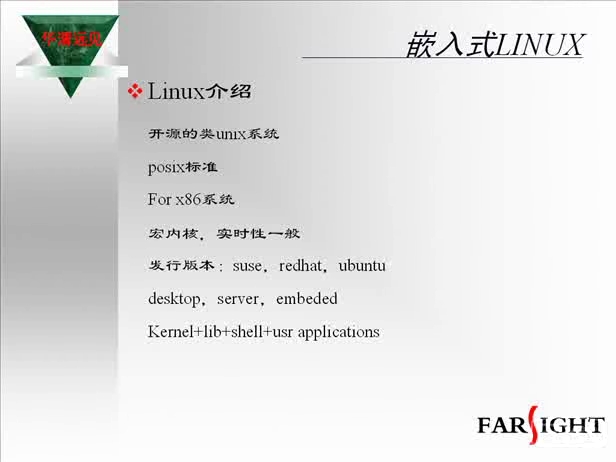Linux下C應(yīng)用程序開發(fā)
本節(jié)用一個實例教你一步步的用 gdb 調(diào)試程序. 被調(diào)試的程序相當(dāng)?shù)暮唵? 但它展示了 gdb 的典型應(yīng)用.
下面列出了將被調(diào)試的程序. 這個程序被稱為 hello , 它顯示一個簡單的問候, 再用反序?qū)⑺谐?
#include stdio.h>;
static void my_print (char *);
static void my_print2 (char *);
static void my_print2 (char *);
main ()
{
char my_string[] = hello world!;
my_print (my_string);
my_print2 (my_string);
}
{
char my_string[] = hello world!;
my_print (my_string);
my_print2 (my_string);
}
void my_print (char *string)
{
printf (The string is %s , string);
}
{
printf (The string is %s , string);
}
void my_print2 (char *string)
{
char *string2;
int size, i;
{
char *string2;
int size, i;
size = strlen (string);
string2 = (char *) malloc (size + 1);
for (i = 0; i size; i++)
string2[size - i] = string;
string2[size+1] = '';
string2 = (char *) malloc (size + 1);
for (i = 0; i size; i++)
string2[size - i] = string;
string2[size+1] = '';
printf (The string printed backward is %s , string2);
}
用下面的命令編譯它:
}
用下面的命令編譯它:
gcc -g -o hello hello.c
這個程序執(zhí)行時顯示如下結(jié)果:
../hello
The string is hello world!
這個程序執(zhí)行時顯示如下結(jié)果:
../hello
The string is hello world!
The string printed backward is
輸出的第一行是正確的, 但第二行打印出的東西并不是我們所期望的. 我們所設(shè)想的輸出
應(yīng)該是:
輸出的第一行是正確的, 但第二行打印出的東西并不是我們所期望的. 我們所設(shè)想的輸出
應(yīng)該是:
The string printed backward is !dlrow olleh
由于某些原因, my_print2 函數(shù)沒有正常工作. 讓我們用 gdb 看看問題究竟出在哪兒,
先鍵入如下命令:
由于某些原因, my_print2 函數(shù)沒有正常工作. 讓我們用 gdb 看看問題究竟出在哪兒,
先鍵入如下命令:
gdb hello
------------------------------------------------------------------------------
--
--
注意: 記得在編譯 hello 程序時把調(diào)試選項打開.
------------------------------------------------------------------------------
--
--
如果你在輸入命令時忘了把要調(diào)試的程序作為參數(shù)傳給 gdb , 你可以在 gdb 提示符下用
file 命令來載入它:
file 命令來載入它:
(gdb) file hello
這個命令將載入 hello 可執(zhí)行文件就象你在 gdb 命令行里裝入它一樣.
這個命令將載入 hello 可執(zhí)行文件就象你在 gdb 命令行里裝入它一樣.
這時你能用 gdb 的 run 命令來運行 hello 了. 當(dāng)它在 gdb 里被運行后結(jié)果大約會象這樣:
(gdb) run
Starting program: /root/hello
The string is hello world!
The string printed backward is
Program exited with code 040
這個輸出和在 gdb 外面運行的結(jié)果一樣. 問題是, 為什么反序打印沒有工作? 為了找出癥結(jié)所在, 我們可以在 my_print2 函數(shù)的 for 語句后設(shè)一個斷點, 具體的做法是在 gdb
提示符下鍵入 list 命令三次, 列出源代碼:
這個輸出和在 gdb 外面運行的結(jié)果一樣. 問題是, 為什么反序打印沒有工作? 為了找出癥結(jié)所在, 我們可以在 my_print2 函數(shù)的 for 語句后設(shè)一個斷點, 具體的做法是在 gdb
提示符下鍵入 list 命令三次, 列出源代碼:
(gdb) list
(gdb) list
(gdb) list
------------------------------------------------------------------------------
--
--
技巧: 在 gdb 提示符下按回車健將重復(fù)上一個命令.
------------------------------------------------------------------------------
--
--
第一次鍵入 list 命令的輸出如下:
1 #include stdio.h>;
2
3 static void my_print (char *);
4 static void my_print2 (char *);
5
6 main ()
7 {
8 char my_string[] = hello world!;
9 my_print (my_string);
10 my_print2 (my_string);
2
3 static void my_print (char *);
4 static void my_print2 (char *);
5
6 main ()
7 {
8 char my_string[] = hello world!;
9 my_print (my_string);
10 my_print2 (my_string);
如果按下回車, gdb 將再執(zhí)行一次 list 命令, 給出下列輸出:
11 }
12
13 void my_print (char *string)
14 {
15 printf (The string is %s , string);
16 }
17
18 void my_print2 (char *string)
19 {
20 char *string2;
再按一次回車將列出 hello 程序的剩余部分:
12
13 void my_print (char *string)
14 {
15 printf (The string is %s , string);
16 }
17
18 void my_print2 (char *string)
19 {
20 char *string2;
再按一次回車將列出 hello 程序的剩余部分:
21 int size, i;
22
23 size = strlen (string);
24 string2 = (char *) malloc (size + 1);
25 for (i = 0; i size; i++)
26 string2[size - i] = string;
27 string2[size+1] = '';
28
29 printf (The string printed backward is %s , string2);
30 }
根據(jù)列出的源程序, 你能看到要設(shè)斷點的地方在第26行, 在 gdb 命令行提示符下鍵入如下命令設(shè)置斷點:
22
23 size = strlen (string);
24 string2 = (char *) malloc (size + 1);
25 for (i = 0; i size; i++)
26 string2[size - i] = string;
27 string2[size+1] = '';
28
29 printf (The string printed backward is %s , string2);
30 }
根據(jù)列出的源程序, 你能看到要設(shè)斷點的地方在第26行, 在 gdb 命令行提示符下鍵入如下命令設(shè)置斷點:
(gdb) break 26
gdb 將作出如下的響應(yīng):
gdb 將作出如下的響應(yīng):
Breakpoint 1 at 0x804857c: file hello.c, line 26.
(gdb)
現(xiàn)在再鍵入 run 命令, 將產(chǎn)生如下的輸出:
Starting program: /root/hello
The string is hello world!
Breakpoint 1, my_print2 (string=0xbffffab0 hello world!) at hello.c:26
26 string2[size - i] = string;
你能通過設(shè)置一個觀察 string2[size - i] 變量的值的觀察點來看出錯誤是怎樣產(chǎn)生的,
做法是鍵入:
26 string2[size - i] = string;
你能通過設(shè)置一個觀察 string2[size - i] 變量的值的觀察點來看出錯誤是怎樣產(chǎn)生的,
做法是鍵入:
(gdb) watch string2[size - i]
gdb 將作出如下回應(yīng):
gdb 將作出如下回應(yīng):
Hardware watchpoint 2: string2[size - i]
現(xiàn)在可以用 next 命令來一步步的執(zhí)行 for 循環(huán)了:
現(xiàn)在可以用 next 命令來一步步的執(zhí)行 for 循環(huán)了:
(gdb) next
經(jīng)過第一次循環(huán)后, gdb 告訴我們 string2[size - i] 的值是 `h`. gdb 用如下的顯示來告訴你這個信息:
經(jīng)過第一次循環(huán)后, gdb 告訴我們 string2[size - i] 的值是 `h`. gdb 用如下的顯示來告訴你這個信息:
Hardware watchpoint 2: string2[size - i]
Old value = 0 '00'
New value = 104 'h'
my_print2 (string=0xbffffab0 hello world!) at hello.c:25
25 for (i = 0; i size; i++)
這個值正是期望的. 后來的數(shù)次循環(huán)的結(jié)果都是正確的. 當(dāng) i=11 時, 表達式
string2[size - i] 的值等于 `!`, size - i 的值等于 1, 最后一個字符已經(jīng)拷到新串里了.
New value = 104 'h'
my_print2 (string=0xbffffab0 hello world!) at hello.c:25
25 for (i = 0; i size; i++)
這個值正是期望的. 后來的數(shù)次循環(huán)的結(jié)果都是正確的. 當(dāng) i=11 時, 表達式
string2[size - i] 的值等于 `!`, size - i 的值等于 1, 最后一個字符已經(jīng)拷到新串里了.
如果你再把循環(huán)執(zhí)行下去, 你會看到已經(jīng)沒有值分配給 string2[0] 了, 而它是新串的第一個字符, 因為 malloc 函數(shù)在分配內(nèi)存時把它們初始化為空(null)字符. 所以 string2 的第一個字符是空字符. 這解釋了為什么在打印 string2 時沒有任何輸出了.
現(xiàn)在找出了問題出在哪里, 修正這個錯誤是很容易的. 你得把代碼里寫入 string2 的第一個字符的的偏移量改為 size - 1 而不是 size. 這是因為 string2 的大小為 12, 但起始偏移量是 0, 串內(nèi)的字符從偏移量 0 到 偏移量 10, 偏移量 11 為空字符保留.
改正方法非常簡單. 這是這種解決辦法的代碼:
#include stdio.h>;
static void my_print (char *);
static void my_print2 (char *);
static void my_print2 (char *);
main ()
{
char my_string[] = hello world!;
my_print (my_string);
my_print2 (my_string);
}
{
char my_string[] = hello world!;
my_print (my_string);
my_print2 (my_string);
}
void my_print (char *string)
{
printf (The string is %s , string);
}
{
printf (The string is %s , string);
}
void my_print2 (char *string)
{
char *string2;
int size, i;
{
char *string2;
int size, i;
size = strlen (string);
string2 = (char *) malloc (size + 1);
for (i = 0; i size; i++)
string2[size -1 - i] = string;
string2[size] = '';
主站蜘蛛池模板:
桐梓县|
来宾市|
循化|
宜州市|
商都县|
信宜市|
陆川县|
射洪县|
宜川县|
浦北县|
平舆县|
金山区|
深水埗区|
盐池县|
岳阳县|
东辽县|
石泉县|
怀远县|
湘西|
湘阴县|
克山县|
定州市|
花垣县|
青海省|
洛宁县|
松潘县|
定襄县|
普兰县|
木兰县|
东阿县|
九寨沟县|
赞皇县|
山东省|
陆良县|
顺义区|
赤峰市|
清徐县|
泊头市|
克拉玛依市|
蓝山县|
宁乡县|
string2 = (char *) malloc (size + 1);
for (i = 0; i size; i++)
string2[size -1 - i] = string;
string2[size] = '';
printf (The string printed backward is %s , string2);
}
如果程序產(chǎn)生了core文件,可以用gdb hello core命令來查看程序在何處出錯。如在函數(shù)my_print2()中,如果忘記了給string2分配內(nèi)存 string2 = (char *) malloc (size + 1);,很可能就會 core dump. linux操作系統(tǒng)文章專題:linux操作系統(tǒng)詳解(linux不再難懂)
}
如果程序產(chǎn)生了core文件,可以用gdb hello core命令來查看程序在何處出錯。如在函數(shù)my_print2()中,如果忘記了給string2分配內(nèi)存 string2 = (char *) malloc (size + 1);,很可能就會 core dump. linux操作系統(tǒng)文章專題:linux操作系統(tǒng)詳解(linux不再難懂)
linux相關(guān)文章:linux教程













評論